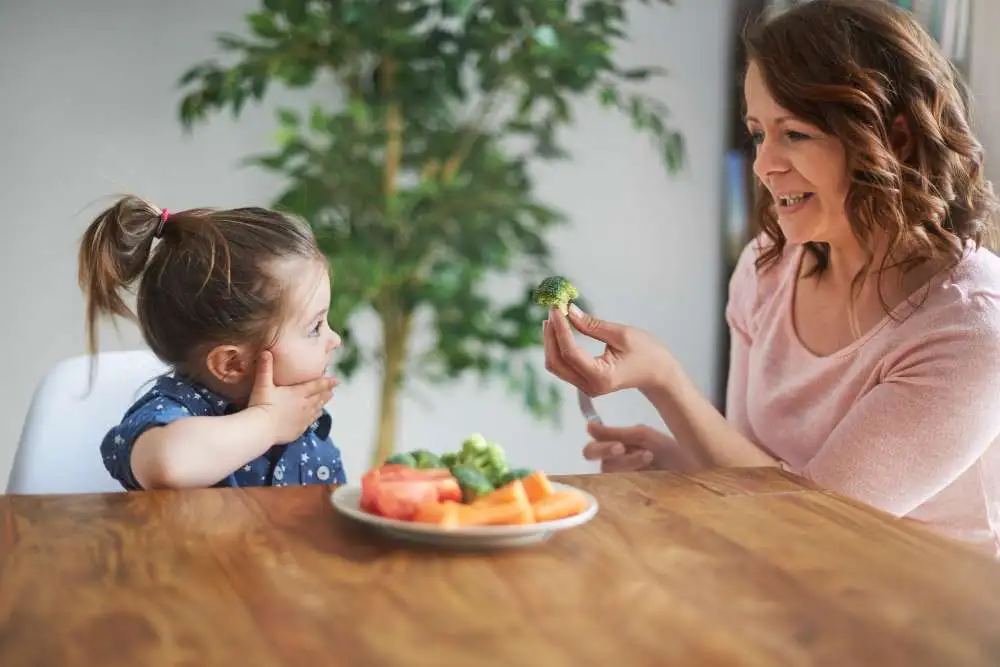Table of Contents
Feeding a 2–6-year-old can feel like a never-ending puzzle.
One day they love dal-rice. The next day, they refused even a single spoon.
Grandparents say, “Give more ghee.” Social media says, “No sugar, no maida, no fried food ever.”
Teachers quietly worry: Is this child getting enough to stay focused and calm in class?
If you are:
- A parent or homemaker
- A daycare/preschool teacher
- An aspiring Montessori teacher
…this guide is for you.
In this blog, we’ll cover:
- What a balanced diet really means for Montessori-aged children
- India-friendly meal ideas using everyday ingredients
- How to combine nutrition + Montessori principles to build independence
- Gentle strategies for picky eaters
- Classroom-friendly food routines and policies
- How Entri’s Montessori TTC course helps teachers integrate nutrition and practical life skills into daily routines
Why a Balanced Diet Matters So Much Between Ages 2 and 6
The years from 2 to 6 are often called the “Montessori years”, when children absorb language, social habits, movement patterns and emotional responses at a rapid pace.
At the same time, they are also:
- Growing quickly in height and weight
- Developing brain connections that support attention, memory and self-control
- Building the immune system that will carry them through school years
Good nutrition in these years supports:
1. Brain Development & Concentration
Nutrients like iron, iodine, B-vitamins, omega-3 fats and zinc are closely linked to attention, memory and learning. Iron deficiency, for example, is common in Indian children and can affect cognition and behaviour if not addressed.
2. Physical Growth & Strength
Children need enough protein, calcium, calories and vitamin D to support bone growth, muscle development and active play. A balanced daily pattern across grains, pulses, dairy and vegetables helps cover these needs.
3. Immunity & Illness Recovery
Vitamin C, zinc, vitamin A and a generally diverse diet support a healthy immune response and help children recover faster from common infections.
4. Lifelong Relationship With Food
Equally important: how we feed a child shapes their attitude towards food.
- Calm, respectful, predictable mealtimes → curiosity and self-regulation
- Pressure, bribery and force-feeding → anxiety, power struggles and “fussy” eating
The Montessori approach treats food as both nourishment and education: children pour water, cut bananas, serve themselves, clean up, all of which builds coordination, confidence and respect.
Register for the Entri Elevate Montessori Teacher Training Program! Click here to join!
What Does a “Balanced Diet” Look Like for Montessori-Aged Children?
1: What is the primary focus of the first plane of development in the Montessori method?
Think less in terms of “perfect” meals and more in terms of daily patterns.
A balanced day for a 2–6 year-old usually includes:
1. Complex Carbohydrates (Energy + Fibre)
These give steady energy and prevent sudden crashes:
- Grains & millets: rice, brown rice, wheat, ragi, jowar, bajra, oats, quinoa
- Traditional staples: idli, dosa, upma, chapati, poha, khichdi
Try to mix white and whole grains instead of only maida-based foods.
2. Quality Proteins (Growth & Repair)
Aim to include a protein source in most major meals:
- Vegetarian options: lentils (moong, masoor, toor, chana), rajma, chole, sprouted pulses, paneer, curd, milk, soya, tofu
- Non-vegetarian options: egg, fish, chicken, small amounts of lean meat (where culturally appropriate)
3. Healthy Fats (Brain & Nerves)
Kids need fats , just the right kind and quantity:
- Traditional fats in small amounts: ghee, sesame (til) oil, mustard oil, groundnut oil
- Other options (where affordable): nuts, seeds, avocado
4. Fruits & Vegetables (Vitamins, Minerals & Fibre)
Colour on the plate = variety of nutrients:
- Daily mix of green, orange, white, red and purple vegetables
- 1–2 fruit servings (banana, guava, papaya, citrus fruits, apple, seasonal local fruits)
5. Dairy or Calcium-Rich Alternatives
For bone health and muscle function:
- Milk, curd, paneer, cheese (in moderation)
- Fortified plant milks if dairy is not tolerated (check paediatric advice)
6. Micronutrients to Keep an Eye On
In Indian children, common concerns include:
- Iron – low intake can cause tiredness, pallor and frequent infections
- Vitamin D – in many urban families, lack of sunlight + indoor lifestyles increase deficiency risk
- Vitamin B12 – especially in strictly vegetarian diets
- Iodine and zinc – important for growth and immunity
Always discuss supplementation with a paediatrician, not the internet.
Get Certified & Start Your Montessori Career
Montessori Teacher Training Course by Entri App: Gain expert skills, earn certification, and kickstart your teaching career.
Join Now!Practical Portion Guide for Ages 2–6
Appetites in this age group are small and can vary day to day. Instead of counting calories, use a mix of:
- Rough volume guides
- Child’s own hunger/fullness cues
- Growth chart discussed with the paediatrician
Simple Daily Portion Idea (Adjust as Needed)
- Breakfast
- 1 small bowl oats / upma / poha or
- 1–2 small idlis or a small stuffed paratha
- 1 fruit serving (½ banana OR 6–8 grapes OR small slice of papaya)
- 1 small bowl oats / upma / poha or
- Mid-morning snack
- Small handful roasted chana or makhana
- OR small bowl curd
- OR a piece of fruit
- Small handful roasted chana or makhana
- Lunch
- 2–3 tablespoons cooked rice or 1 small chapati
- 2–3 tablespoons cooked vegetable
- 2–3 tablespoons dal / paneer / egg curry
- 2–3 tablespoons cooked vegetable
- 2–3 tablespoons cooked rice or 1 small chapati
- Evening snack
- Vegetable sticks with curd/hummus dip
- OR small dosa/poha/upma portion
- Vegetable sticks with curd/hummus dip
- Dinner
- Similar to lunch, slightly lighter;
- Khichdi, simple dal-chawal, or soft rotis with sabzi work well
- Similar to lunch, slightly lighter;
- Milk
- Around 150–250 ml once or twice a day, adjusted for the rest of the diet and pediatric advice
💡 Montessori-friendly tip:
Use the child’s fist as a guide , their fist ≈ one serving of veggies or grains for them. Their palm ≈ one serving of protein. This is more intuitive and respectful than “finish everything on the plate.”
India-Friendly 3-Day Sample Meal Plan (2–6 Years)
Use this as inspiration, not a rigid rule. Swap items based on region, season and family preferences.
Day 1
- Breakfast: Vegetable upma with peas + ½ banana
- Snack: Roasted makhana + small glass buttermilk
- Lunch:
- 1 small chapati
- Moong dal tadka (mild)
- Mixed vegetable curry (carrot, beans, peas)
- 2–3 spoons plain curd
- 1 small chapati
- Evening snack: Cucumber & carrot sticks + hummus / simple curd dip
- Dinner: Soft moong–rice khichdi with a little ghee + small apple slices
Day 2
- Breakfast: Oats porridge cooked in milk, sweetened with mashed mango or banana + a few finely chopped almonds (for older children who can safely chew)
- Snack: Sprouted moong chaat with tomato, cucumber, lemon
- Lunch:
- Rice
- Rajma (mild, less spice)
- Seasonal vegetable sabzi
- Cucumber raita
- Rice
- Evening snack: Small besan chilla with curd
- Dinner: Light vegetable pulao + papaya cubes
Day 3
- Breakfast: Small vegetable paratha (carrot/palak) + plain curd
- Snack: Fruit chaat (banana, orange segments, pomegranate)
- Lunch:
- Millet roti (ragi/jowar)
- Simple dal
- Lightly sautéed greens (palak / methi)
- Millet roti (ragi/jowar)
- Evening snack: Paneer cubes (lightly sautéed) or baked soya nuggets + a few grapes
- Dinner: Vegetable soup (carrot, pumpkin, tomato) + 1 small chapati
Rotate pulses, grains and vegetables over the week so children see many colours, textures and tastes.
Key Nutrients: Iron, Vitamin D & B12 , What Parents Should Know
Iron
Helps carry oxygen in the blood and supports brain development.
Good Indian sources:
- Lentils, rajma, chole, black chana
- Ragi, bajra, red rice
- Dark leafy greens (spinach, amaranth)
- Jaggery (in moderation), sesame seeds
💡 Combine plant-based iron foods with vitamin C (lemon, guava, orange, tomato) to improve absorption.
Vitamin D
Important for bones, immunity and mood.
- Main natural source is sunlight on skin
- Many children may need supplementation depending on lifestyle and region , always check with a paediatrician
Vitamin B12 (for Vegetarian Families)
Found mostly in:
- Dairy (milk, paneer, curd)
- Eggs
- Fortified foods (check labels)
If your family is strictly vegetarian, discuss B12 status with your paediatrician.
Get Certified & Start Your Montessori Career
Montessori Teacher Training Course by Entri App: Gain expert skills, earn certification, and kickstart your teaching career.
Join Now!Montessori-Aligned Feeding Practices: Food as Practical Life
Montessori philosophy places practical life activities at the heart of early education , and food is a big part of that.
Instead of thinking, “How do I make them eat more?”, think:
“How can I invite my child to participate in food and mealtimes?”
1. Child-Sized Tools
Offer:
- Small plate, tumbler and spoon
- Short-handled jug for water
- Child-safe knife or butter spreader for soft foods
This builds coordination and confidence, and children eat better when they feel ownership.
2. Serve-Yourself Setups
- Place fruits/veggies in small bowls on a low table
- Let the child choose and serve their portion
- You can quietly guide (“Maybe start with one spoon, you can take more later”)
3. Simple Food Preparation Tasks
Even a 2–3-year-old can:
- Wash grapes or tomatoes in a small bowl
- Arrange banana slices on a plate
- Spread chutney or peanut butter
- Carry their plate to the table
A 4–6-year-old can:
- Peel boiled potatoes or eggs
- Mix curd rice
- Help knead dough with you
- Set and clear the table
These are Montessori practical-life activities that also improve eating: children are more likely to taste what they helped make.
4. Calm, Respectful Mealtimes
- Sit together at the table, with screens off
- Avoid scolding or bribing
- Use neutral language:
- ✅ “This carrot is crunchy and sweet.”
- ❌ “If you don’t eat your carrot, no cartoon.”
- ✅ “This carrot is crunchy and sweet.”
The goal is curiosity, not fear.
Picky Eaters: Gentle, Research-Backed Strategies
Nearly every child goes through a “picky phase”. It is usually developmental, not a parenting failure.
Try these, the Montessori way:
- Small Portions, Low Pressure
- Offer tiny servings of a new food alongside familiar favourites
- Let them taste and reject; exposure matters more than quantity
- Offer tiny servings of a new food alongside familiar favourites
- Repeated Neutral Exposure
- It can take 10–15 exposures to accept a new food
- Keep offering, without “lectures” or bargaining
- It can take 10–15 exposures to accept a new food
- Pair New with Loved
- Add a new vegetable to familiar dal, khichdi or paratha
- Or offer it as a side next to a favourite food
- Add a new vegetable to familiar dal, khichdi or paratha
- No Bribes, No Punishments
- Dessert as a “reward” for eating dal teaches that dal is “bad” and dessert is “good”
- Instead, keep treats predictable and not linked to performance
- Dessert as a “reward” for eating dal teaches that dal is “bad” and dessert is “good”
- Model What You Want to See
- Eat the same food, at the same table
- Comment casually: “I like how juicy this orange is.”
- Eat the same food, at the same table
- Involve Them in Shopping & Cooking
- Ask, “Should we try bhindi or beans today?”
- Let them wash, peel or stir even if it gets messy , this is learning.
- Ask, “Should we try bhindi or beans today?”
If your child is losing weight, refusing entire food groups for months, or seems unusually anxious around food, speak with a paediatrician or child-feeding specialist.
Hydration, Sugar & Processed Foods: Simple Rules That Work
Hydration
- Offer plain water through the day
- Limit fruit juices; if given, dilute and treat as a small snack, not a main drink
- Avoid fizzy drinks and sugary beverages as far as possible
Sugar & Treats
- Occasional sweets are okay; daily habit is not
- Keep them limited, specific and predictable (e.g., one sweet item on Sunday afternoon)
Processed Packaged Foods
- Chips, biscuits, instant noodles, sugary cereals and processed meats are best kept occasional
- They often contain excess salt, sugar and unhealthy fats that displace nutrient-rich foods
Think 80–90% home-style food, 10–20% treats , not perfection, just balance.
Montessori Classroom & School Food Policies: What Works Best
For Montessori schools, food is part of the learning environment. Simple, clear policies can protect health and support focus.
1. Clear Snack Guidelines
- Encourage whole fruits, homemade snacks, simple Indian items (idli, dhokla, poha, paratha)
- Discourage chocolates, cream biscuits, chips and sugary drinks
2. Allergy Awareness
- Maintain a confidential list of allergies
- Have nut-free tables or entire nut-free policies when needed
- Train staff for emergency responses where severe allergies exist
3. Predictable Routine
- Fixed snack and lunch times help children’s bodies and minds regulate
- Avoid high-energy lessons right after heavy meals
4. Practical-Life Integration
- Let children lay out mats, set their places, pour water, serve fruit, wipe tables
- These are powerful moments for independence and social skills, not “time waste”
5. Hygiene & Safety
- Hand-washing before and after meals
- Safe storage and reheating of any school-prepared foods
When teachers are trained in both child development and practical life with food, the classroom becomes a place where healthy eating and independence reinforce each other.
How Entri’s Montessori TTC Course Supports Nutrition & Practical Life
If you are an aspiring Montessori teacher or a preschool owner, you may be wondering:
“How do I bring all this into my classroom systematically, not just as a one-time activity?”
This is where a structured training like Entri’s Montessori TTC course becomes extremely valuable.
Through the course, teachers learn to:
- Design practical-life food activities
- Age-appropriate cutting, pouring, serving, tidying
- Setting up child-sized kitchen corners and snack stations
- Age-appropriate cutting, pouring, serving, tidying
- Understand child development (2–6 years)
- Natural appetite variations
- Sensory stages and how texture, smell and colour affect food acceptance
- Natural appetite variations
- Integrate food into the curriculum
- Counting dal for maths
- Naming fruits/vegetables in language lessons
- Exploring regional foods in cultural studies
- Counting dal for maths
- Communicate effectively with parents
- Share sample menus and snack guidelines
- Offer gentle, respectful suggestions for lunchbox planning
- Coordinate handling of allergies and special dietary needs
- Share sample menus and snack guidelines
- Use food time as a learning lab
- Observing children’s concentration
- Building grace & courtesy (waiting turn, passing bowls, saying “please” and “thank you”)
- Observing children’s concentration
With Entri’s Montessori TTC, teachers don’t just learn theory; they practice setting up and managing these routines so that snack time becomes a daily lesson in independence, care and community.
Entri’s Montessori TTC – where teachers go from just learning theory, to actually making those routines stick. So that what’d otherwise be just another boring old snack time, ends up being a daily lesson in independence, care and community.
When Do You Know to Get Some Outside Help?
If you’re a parent or a teacher and you notice any of these things, it’s a good idea to get some professional advice:
- The kid just isn’t putting on weight, or they’re losing weight and you don’t know why
- They just won’t eat anything, or they get really anxious about eating
- They keep getting the runs, or they’re vomiting, or they’ve had diarrhoea that just won’t clear up
- You’re starting to see some signs that they might not be getting enough of certain important nutrients (pale skin, for example, or they’re always tired, or they keep getting sick)
- You think they might have a food allergy (like a rash after eating certain foods, or swelling up, or having a hard time breathing)
Get on top of it early, and you can stop little problems from turning into big ones down the line.
Key Takeaways:
- Give your kid some variety, and don’t sweat it if they don’t want to try everything right off. Rotate up different grains, pulses, fruits and veggies and what have you.
- Make sure they’re getting enough iron, vitamin D, protein and calcium. It’s all about the basics
- Keep the portions small and the eating frequent. A good rule of thumb is to look at the size of your kid’s hand – if the food’s coming up to that, it’s a good size for them to eat.
- Use Montessori practical life activities (like washing, cutting, serving, cleaning) to get them involved and excited about food.
- If you’ve got a picky eater, just stick to being calm and patient – don’t try to bribe them or yell at them to eat something.
- Ditch the sugary and highly processed foods, and get them drinking water all the time – it’s the way to go.
- In a school setting, just have some simple snack policies and allergy management procedures in place to keep everyone safe.
- If you’ve got ongoing worries about your kid’s eating and you’re not sure what to do, just reach out to a paediatrician – don’t rely on just the internet.
- If you want to get some professional training to teach you how to make nutrition and practical life a part of every school day, then Entri’s Montessori TTC is the way to go.
Final Thought:
At the end of the day, a balanced diet is not just about feeding your kid the perfect mix of foods. It’s about how they feel while they’re eating, and how they feel about food.
- They should feel like they’re in charge, not like their parents are trying to control them.
- They should feel included, not like they’re being left out.
- They should feel curious, not scared.
The Montessori approach gives us a gentle way to turn every meal and snack into an opportunity for our kids to learn and connect with us.
If you’re a parent, start small this week: let your kid wash the fruits for dinner, or offer them one new veggie without making a big fuss. Just sit with them and talk about the colours on the plate.
If you’re an aspiring teacher and you want to design a classroom where kids can learn about nutrition and independence, then Entri’s Montessori TTC is the place to go. Over time, it all adds up to lifelong healthy eating patterns, not just for the body but for the mind too
| Also Read | |
| 5 Ways Montessori Teacher Training Benefits Children | |
| What Qualifications Do You Need for Kindergarten Teacher Jobs? |
|
| Montessori Pink Tower Making | |
| Knobbed Cylinders in Montessori | |
Get Certified & Start Your Montessori Career
Montessori Teacher Training Course by Entri App: Gain expert skills, earn certification, and kickstart your teaching career.
Join Now!Frequently Asked Questions
What is a balanced diet for Montessori-aged children (2–6 years)?
A balanced diet for children aged 2–6 includes a mix of complex carbohydrates (rice, wheat, millets), quality proteins (dal, paneer, egg, sprouts), healthy fats (ghee, nuts, seeds), fruits, vegetables, and calcium-rich foods like milk and curd. Children in this age group need small, frequent, nutrient-dense meals because their stomach capacity is still limited.
How much should a 2–6-year-old eat in a day?
Young children need small portions such as 2–3 tablespoons of rice/sabzi/dal per meal, 1–2 small idlis or chapatis, 1–2 fruit servings, and 1–2 small cups of milk. A good rule is to use the child’s fist and palm as a portion guide, their fist equals one serving of vegetables or grains.
What are the best Indian foods for young children?
Ideal options include idli, dosa, upma, poha, khichdi, dal-chawal, curd rice, vegetable paratha, rajma, chole, paneer, eggs, seasonal fruits and vegetables, millets like ragi and jowar, and homemade snacks like chillas, dhokla and roasted makhana.
How can Montessori methods help children eat better?
Montessori encourages independence through child-sized tools, self-serving, simple food preparation, pouring water, setting the table, and exploring food textures and colours. Children who participate in food prep tend to be more willing to try and accept new foods.
How do I deal with a picky eater between ages 2–6?
Use gentle strategies: offer tiny portions, avoid pressure, repeat exposure 10–15 times, pair new foods with familiar ones, model healthy eating, and involve children in prep. Avoid bribes or threats, as these increase food resistance.
Which nutrients are most important for Montessori-aged children?
Key nutrients include iron, vitamin D, calcium, protein, omega-3 fats, iodine and vitamin B12 (especially for vegetarian children). Pairing iron-rich foods with vitamin C helps improve absorption.
How many meals and snacks should young children have?
Most children do best with three small meals + two snacks: breakfast, mid-morning snack, lunch, evening snack, early dinner. This supports steady energy and helps prevent overeating at one time.
What foods should be limited for preschool children?
Limit packaged snacks, sweets, sugary drinks, deep-fried foods, excessive bakery products, heavily spiced curries, and artificial beverages. Water should be the main drink throughout the day.
What are good lunchbox ideas for Montessori schools?
Easy options: mini idlis, vegetable upma, curd rice, roti rolls with paneer, dal parathas, poha, besan chilla, small dosa, fruit slices, steamed veggies, boiled eggs (where allowed), and homemade laddus using jaggery and nuts.
How does the Entri Montessori TTC course help teachers with nutrition education?
Entri’s Montessori TTC course trains teachers in practical-life activities like food prep, pouring, cutting, serving and cleaning. It also teaches child development, sensory learning, communication with parents, and how to integrate nutrition into daily classroom routines to build independence and healthy habits.















